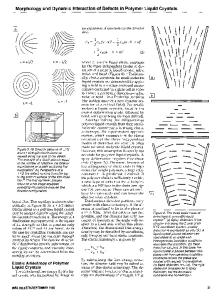Polymer Liquid Crystals and Their Blends: A Hierarchy of Structures
- PDF / 1,590,426 Bytes
- 17 Pages / 420.48 x 639 pts Page_size
- 53 Downloads / 347 Views
POLYMER LIQUID CRYSTALS AND THEIR BLENDS: A HIERARCHY OF STRUCTURES WITOLD BROSTOW* and MICHAEL HESS*, # Center for Materials Characterization and Department of Chemistry, University of North Texas, Denton, TX 76203-5308 # FB6 - Physikalische Chemie, Universitat Duisburg, D-W-4100 Duisburg, Federal Republic of Germany
ABSTRACT Hierarchical structures are possible in polymer liquid crystals (PLCs) since each molecule contains at least two kinds of building blocks that are not homeomorphic to each other. We discuss some examples of molecular structures and phase structures of monomer liquid crystals (MLCs) and PLCs: smectic phases formed by interdigitated MLC molecules; PLC molecule classification based on increasing complexity - and its consequences on properties of the materials; and formation and phase structures of LC-rich islands in PLCs and in PLC blends. Some rules pertaining to hierarchical structures are formulated. The knowledge of hierarchies is neccessary - but not sufficient - for intelligent procesing of PLCs and their blends and for achieving properties defined in advance. Computer modelling represents another important element of building materials to order.
1. INTRODUCTION We need first to distinguish between polymer liquid crystals (PLCs) and monomer liquid crystals (MLCs); the latter are so classified irrespective of the fact whether they can be polymerized or not [1]. Many MLC molecules are fully thermotropic, and thus form purely LC phases. PLCs often contain also flexible sequences which lower the melting point to an accessible temperature; this may results in formation of an LC-rich and an LC-poor phase. PLCs are studied for fundamental reasons as well as because of their properties desirable in applications [2-4]. PLCs are stronger mechanically than flexible polymers because LC sequences typically exhibit some rigidity. Moreover, PLCs have better thermal stability at elevated temperatures, lower thermal expansivity, lower flammability, are stable in
Mat. Res. Soc. Symp. Proc. Vol. 255. 01992 Materials Research Society
58
vacuum, stable against visible and UV light, and often processable more easily than thermoplastic (typically flexible) engineering polymers (EPs). PLCs are more expensive than EPs; hence the idea of PLC + EP blends such that the advantageous properties of pure PLCs remain while the prices are affordable. Several questions appear immediately: how to choose the PLC + EP pair ? What concentration of the PLC is sufficient ? What phase structure would provide the maximum mechanical reinforcement and the best overall properties ? We find that the knowledge of hierarchical PLC structures is essential for answering these questions - and thus for the development of improved polymer-based materials.
2. HIERARCHIES IN POLYMERS: ANTECEDENTS Hierarchical structures are of interest in physical chemistry, polymer science and engineering, solid state physics, the entire materials science and engineering, biochemistry and other disciplines. The importance of hierarchies for polymers has
Data Loading...











